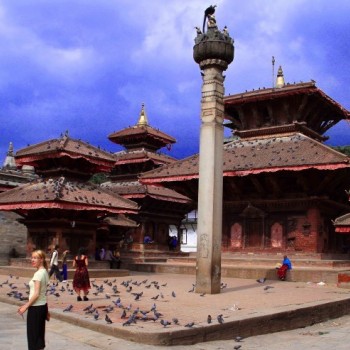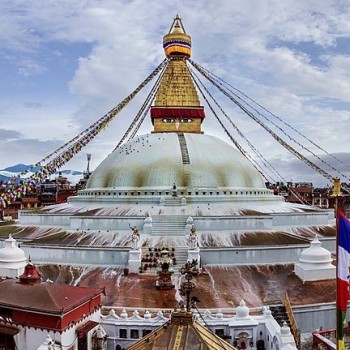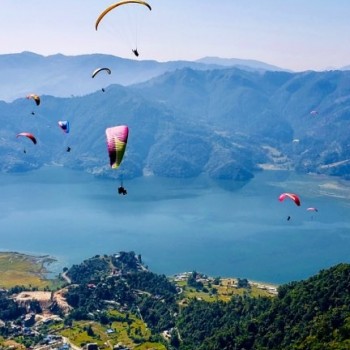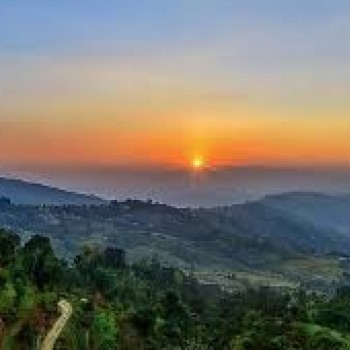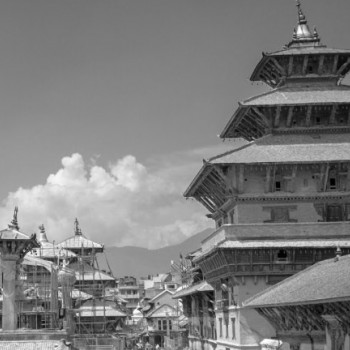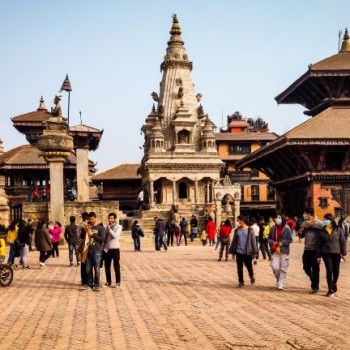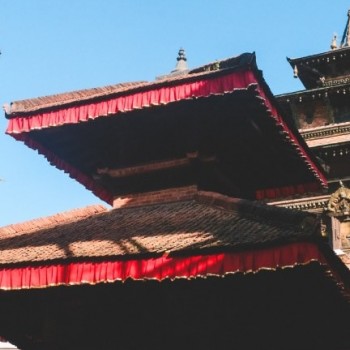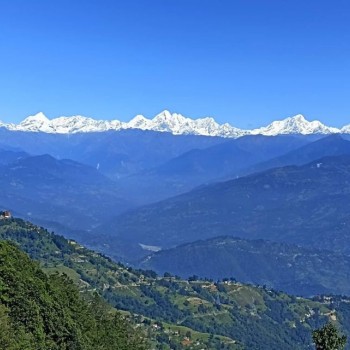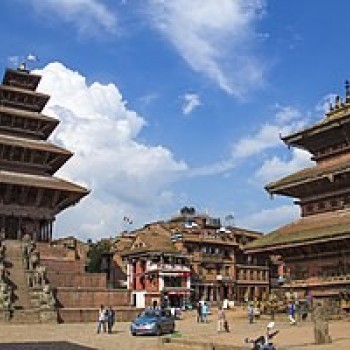City Tour in Kathmandu
Kathmandu, the vibrant capital city of Nepal, is a treasure trove of **cultural heritage**, ancient temples, and bustling markets. As you embark on a city tour in Kathmandu, you will be captivated by the **rich history**, diverse architecture, and the unique blend of traditions that define this enchanting city. Whether you are a history buff, a spiritual seeker, or an adventurer, Kathmandu offers something for everyone. Join us as we take you on an unforgettable journey through the heart of Nepal.
Discovering Durbar Square: The Historical Epicenter
Durbar Square is the historical and cultural epicenter of Kathmandu. This UNESCO World Heritage Site is home to numerous palaces, courtyards, and temples that date back to the 12th century. As you stroll through the square, you will encounter: The Hanuman Dhoka Palace, once the royal residence of the Malla kings and later the Shah dynasty, is a stunning example of traditional Newari architecture. The palace complex houses several courtyards and museums, offering a glimpse into the royal history of Nepal. The Kumari Ghar is the residence of the "Living Goddess or Kumari", a young girl believed to be the incarnation of the Hindu goddess Taleju. Visitors can witness the Kumari during special festivals and ceremonies, a unique experience that highlights the spiritual significance of Kathmandu. The Taleju Temple, dedicated to the goddess Taleju Bhawani, stands majestically in Durbar Square. This 16th-century temple is an architectural marvel, with its towering pagoda-style structure and intricate carvings.
Exploring Swayambhunath: The Monkey Temple
Perched atop a hill overlooking the Kathmandu Valley, Swayambhunath, also known as the Monkey Temple, is one of the most iconic and revered Buddhist stupas in Nepal. The stupa's white dome and gilded spire are adorned with the all-seeing eyes of Buddha, symbolizing enlightenment. Swayambhunath is believed to have been established more than 2,000 years ago. The stupa is surrounded by a variety of shrines, temples, and prayer wheels, each with its own historical and spiritual significance. The hilltop location of Swayambhunath offers panoramic views of the Kathmandu Valley and the surrounding mountains. The site is also home to a large population of monkeys, which adds to its unique charm. The serene and spiritual ambiance of Swayambhunath makes it a popular destination for both pilgrims and tourists. The sound of prayer wheels, the scent of incense, and the sight of colorful prayer flags fluttering in the breeze create a peaceful and contemplative atmosphere.
Boudhanath Stupa: A Center of Tibetan Buddhism
Boudhanath Stupa, another UNESCO World Heritage Site, is one of the largest and most significant Buddhist stupas in the world. Located on the northeastern outskirts of Kathmandu, Boudhanath is a center of Tibetan Buddhism and a focal point for Buddhist rituals and festivals. The massive mandala-shaped stupa is an architectural marvel, with its white dome, golden spire, and the all-seeing eyes of Buddha painted on each side. The stupa is surrounded by a circular walkway, where devotees perform kora, a ritual circumambulation. Boudhanath is surrounded by numerous monasteries and Tibetan shops, reflecting the strong Tibetan influence in the area. The stupa is a hub for Tibetan refugees and monks, making it a vibrant center of Tibetan culture and spirituality. Boudhanath is a focal point for many Buddhist festivals, including Losar (Tibetan New Year) and Buddha Jayanti (Buddha's birthday). These festivals attract thousands of pilgrims and tourists, creating a festive and colorful atmosphere.
Pashupatinath Temple: The Sacred Hindu Shrine
Pashupatinath Temple, located on the banks of the Bagmati River, is one of the holiest Hindu temples dedicated to Lord Shiva. This sprawling temple complex is a UNESCO World Heritage Site and a major pilgrimage site for Hindus from around the world. Pashupatinath is believed to be the seat of the national deity, Lord Pashupatinath. The temple's sanctum sanctorum houses a sacred lingam (symbol of Shiva), which is worshipped by thousands of devotees every day. The temple complex includes several cremation ghats along the Bagmati River, where Hindu cremation rituals are performed. Witnessing these rituals provides a profound insight into Hindu beliefs and practices surrounding death and the afterlife. The temple's pagoda-style architecture, with its intricately carved wooden rafters and golden spire, is a testament to the artistic heritage of the Newar craftsmen. The temple complex also includes numerous smaller shrines and statues dedicated to various deities.
Thamel: The Heart of Tourism in Kathmandu
Thamel, the bustling tourist district of Kathmandu, is a vibrant area filled with shops, restaurants, and hotels. It is the perfect place to experience the lively and dynamic atmosphere of the city. It is a shopper's paradise, offering everything from traditional handicrafts and clothing to trekking gear and souvenirs. The narrow streets are lined with shops selling pashmina shawls, thangka paintings, and other unique items. It is home to a wide variety of restaurants and cafes, serving both local and international cuisine. From traditional Nepali dishes like momos and dal bhat to Italian, Chinese, and Indian food, Thamel caters to every palate. The nightlife in Thamel is vibrant, with numerous bars, pubs, and live music venues. It is a great place to unwind after a day of sightseeing, enjoy live music, and socialize with fellow travelers.
Garden of Dreams: A Tranquil Oasis
The Garden of Dreams, located near Thamel, is a beautifully restored neo-classical garden that offers a tranquil escape from the hustle and bustle of the city. This historical garden, originally built in the early 20th century, is a serene haven filled with exotic plants, ponds, and pavilions. The Garden of Dreams was commissioned by Field Marshal Kaiser Sumsher Rana and designed by architect Kishore Narshingh. The garden fell into disrepair over the years but has been meticulously restored to its former glory. The garden's landscape features a variety of exotic and indigenous plants, well-manicured lawns, and ornate fountains. It is an ideal spot for a leisurely stroll or a peaceful afternoon reading a book. The Garden of Dreams often hosts cultural events, art exhibitions, and performances. These events add to the cultural richness of Kathmandu and provide visitors with an opportunity to experience the local arts scene.
A city tour in Kathmandu is a journey through time and culture, offering a glimpse into the rich heritage and vibrant life of Nepal. From the historical wonders of Durbar Square and the spiritual serenity of Swayambhunath to the bustling streets of Thamel and the tranquil beauty of the Garden of Dreams, Kathmandu is a city that captivates and enchants. Whether you are seeking adventure, spirituality, or cultural immersion, Kathmandu has it all.
City Tour in Bhaktapur
Nestled in the Kathmandu Valley, Bhaktapur, also known as Bhadgaon, is a city that stands as a testament to Nepal's rich cultural heritage and architectural splendor. As one of the three medieval cities in the valley, Bhaktapur offers an unparalleled glimpse into the past with its well-preserved palaces, temples, and traditional Newari culture. Join us on a detailed city tour in Bhaktapur, where history comes alive through its magnificent structures and vibrant traditions.
Bhaktapur Durbar Square is the city's historical epicenter and a UNESCO World Heritage Site. This expansive square is home to some of the most stunning examples of Newari architecture and craftsmanship.
- 55-Window Palace: The 55-Window Palace, built during the reign of King Bhupatindra Malla in the 15th century, is a masterpiece of woodwork and intricate carvings. The palace's golden gate, known as Sun Dhoka, is a striking example of the Newari artisans' skill.
- Vatsala Temple: The Vatsala Temple, constructed in the traditional Shikhara style, is dedicated to the goddess Vatsala Devi. This stone temple is known for its beautiful carvings and the impressive Taleju Bell, which is rung to signal curfews in ancient times.
- Nyatapola Temple: Standing tall in Taumadhi Square, the Nyatapola Temple is a five-story pagoda that dominates the skyline. Built in 1702, it is dedicated to Siddhi Lakshmi, the Hindu goddess of prosperity. The temple is famed for its massive structure and the stone guardians that protect it.
Exploring Taumadhi Square
- Taumadhi Square, located just a short walk from Durbar Square, is another vibrant hub of Bhaktapur, showcasing its living traditions and bustling local life.
- Bhairavnath Temple: The Bhairavnath Temple, dedicated to the fearsome Bhairav deity, features a striking three-tiered pagoda. This temple is an important religious site and a focal point during local festivals.
- Pottery Square: Pottery Square is the heart of Bhaktapur’s traditional pottery industry. Here, you can witness local artisans crafting a variety of earthenware using age-old techniques. The square is filled with rows of clay pots drying in the sun, offering a unique and photogenic scene.
Dattatreya Square: A Cultural Gem
Dattatreya Square is another must-visit area in Bhaktapur, known for its ancient monuments and vibrant cultural life.
- Dattatreya Temple: The Dattatreya Temple, built in 1427, is one of the oldest and most significant temples in Bhaktapur. Dedicated to the triune deity Dattatreya, the temple is famed for its elaborate woodwork and the stunning peacock window, a symbol of Bhaktapur’s artistic heritage.
- Bhimsen Temple: Located near the Dattatreya Temple, the Bhimsen Temple is dedicated to Bhimsen, the god of commerce and trade. This temple is particularly revered by the local business community.
- Brass and Bronze Museum: The Brass and Bronze Museum, housed in a traditional Newari building, showcases a remarkable collection of metalwork artifacts. This museum offers insight into the rich tradition of metal craft in Bhaktapur.
Exploring the Traditional Craftsmanship
Bhaktapur is renowned for its traditional crafts, which are still practiced with the same dedication and skill as in ancient times.
- Woodcarving: The city is famous for its exquisite woodcarving, which adorns temples, palaces, and private homes. Traditional workshops and galleries offer a chance to see artisans at work and purchase unique souvenirs.
- Thangka Painting: Thangka painting is another traditional art form prevalent in Bhaktapur. These intricate Buddhist paintings on cotton or silk canvas are used as teaching tools and meditation aids.
- Papermaking: The traditional craft of papermaking is alive in Bhaktapur, with several workshops producing handmade paper from the bark of the lokta plant. This eco-friendly paper is used for various purposes, including the creation of beautiful journals and lampshades.
The Living Heritage of Festivals
Bhaktapur is a city of festivals, where age-old traditions are celebrated with great fervor and enthusiasm.
- Bisket Jatra is Bhaktapur's most famous festival, celebrated in April to mark the Nepalese New Year. The festival features chariot processions, tug-of-war contests, and other traditional rituals, attracting thousands of visitors.
- Gai Jatra, or the Festival of Cows, is held in August to commemorate the deceased. Families who have lost loved ones in the past year parade through the streets, dressed in colorful costumes and accompanied by cows, which are believed to help guide the departed souls.
- Dashain, the longest and most significant Hindu festival in Nepal, is celebrated with great pomp and ceremony in Bhaktapur. The city's temples and homes are beautifully decorated, and traditional rituals are performed to honor the goddess Durga.
Bhaktapur’s Culinary Delights
No tour of Bhaktapur is complete without sampling its unique and delicious cuisine. The city offers a variety of traditional Newari dishes that tantalize the taste buds.
- Juju Dhau, Known as the "King of Yogurt," Juju Dhau is a must-try delicacy in Bhaktapur. This creamy, rich yogurt is traditionally made from buffalo milk and served in clay pots.
- Bara is a popular Newari snack made from ground lentils and spices, often topped with an egg or meat. This savory pancake is both nutritious and delicious.
- Chhoila is a spicy grilled meat dish, typically made from buffalo meat and marinated with a blend of spices and herbs. It is a favorite among locals and a perfect accompaniment to other Newari dishes.
A City tour in Bhaktapur is a journey through a living museum of culture, art, and tradition. From the historical grandeur of Durbar Square and the bustling life of Taumadhi Square to the artisanal charm of Pottery Square and the serene beauty of Dattatreya Square, Bhaktapur offers an immersive experience into Nepal's rich heritage. Whether you are exploring ancient temples, witnessing traditional crafts, or indulging in local cuisine, Bhaktapur promises a memorable and enriching experience.
City Tour in Patan
Patan, also known as Lalitpur, is one of the ancient royal cities in the Kathmandu Valley, renowned for its rich cultural heritage, exquisite craftsmanship, and historical significance. A city tour in Patan offers a deep dive into the heart of Nepal's artistic and architectural brilliance. Join us as we explore the timeless beauty of Patan, uncovering its historical landmarks, vibrant local life, and traditional crafts.
Patan Durbar Square: The Cultural Heartbeat
Patan Durbar Square is the cultural and historical heart of the city. This UNESCO World Heritage Site is a spectacular display of Newari architecture, with its array of palaces, temples, and courtyards.
Patan Museum
Housed within the former royal palace, the Patan Museum is a treasure trove of artifacts showcasing Nepal's rich artistic heritage. The museum's collection includes bronze sculptures, traditional crafts, and religious art, providing visitors with a comprehensive understanding of the region's history and culture.
Krishna Mandir
Krishna Mandir is one of the most iconic temples in Patan Durbar Square. Built entirely of stone in the Shikhara style, this 17th-century temple is dedicated to Lord Krishna and features intricate carvings depicting scenes from the Mahabharata and Ramayana.
Hiranya Varna Mahavihar
Known as the Golden Temple, Hiranya Varna Mahavihar is a stunning Buddhist monastery adorned with gilded metal plates. This 12th-century monastery is an active place of worship and a fine example of the religious harmony in Patan.
Exploring the Traditional Craftsmanship of Patan
Patan is renowned for its traditional crafts, which are still practiced with great dedication. The city's artisans are known for their skills in metalwork, woodcarving, and stone sculpture.
- Metalwork and Statues: The narrow alleys of Patan are filled with workshops where skilled artisans create intricate metal statues of deities and mythical creatures. These bronze and copper statues are sought after for their exquisite detail and craftsmanship.
- Woodcarving: Woodcarving is another traditional craft that thrives in Patan. The city's temples and buildings are adorned with beautifully carved wooden windows, doors, and beams, showcasing the artisans' incredible skill.
- Stone Sculpture: Patan is also famous for its stone sculptures, which can be seen throughout the city. These sculptures, often depicting religious figures, are carved with great precision and artistry.
Kumbheshwar Temple: The Sacred Shiva Shrine
Kumbheshwar Temple is one of the oldest and most important temples in Patan. Dedicated to Lord Shiva, this five-tiered pagoda-style temple dates back to the 14th century and is a major pilgrimage site. Kumbheshwar Temple holds great historical and religious significance. It is believed that the temple's central shrine was established by King Jayasthiti Malla, making it one of the oldest in the valley. The temple complex includes a sacred pond, which is believed to be connected to the holy Bagmati River. Pilgrims visit this pond during the Janai Purnima festival to bathe and purify themselves.
Festivals in Patan
Patan is a city of festivals, where traditional celebrations are an integral part of daily life. These festivals reflect the city's rich cultural heritage and religious diversity.
- Rato Machhindranath Jatra is one of the most important and colorful festivals in Patan. This month-long festival involves the chariot procession of the Rato Machhindranath deity, symbolizing rain and good harvest.
- Bhoto Jatra marks the end of the Rato Machhindranath festival. During this event, a sacred jewel-studded vest (bhoto) is displayed to the public, attracting thousands of spectators.
- Indra Jatra, celebrated in September, is a vibrant festival dedicated to Lord Indra, the god of rain. The festival features masked dances, processions, and various traditional rituals, bringing the streets of Patan to life.
Tasting Patan's Culinary Delights
Patan's culinary scene is a reflection of its rich cultural heritage. The city's local cuisine is a delightful blend of flavors and traditions.
- Newari cuisine, native to the Kathmandu Valley, is a must-try in Patan. Dishes like **sapu mhicha** (buffalo tripe stuffed with bone marrow), **yomari** (a sweet steamed dumpling), and **bara** (lentil patties) are some of the local specialties.
- Often referred to as the "Newari pizza," Chatamari is a rice flour crepe topped with minced meat, eggs, and vegetables. It is a popular snack that offers a burst of flavors.
- Juju Dhau, or "King of Yogurt," is a creamy, rich yogurt that originated in Bhaktapur but is also widely enjoyed in Patan. It is traditionally served in clay pots, adding to its unique taste and texture.
Exploring Patan's Markets and Shopping
Patan's markets are vibrant hubs of activity, offering a variety of traditional crafts, souvenirs, and local products.
- Mangal Bazaar, located near Durbar Square, is a bustling market where you can find a wide range of traditional crafts, jewelry, and textiles. It is the perfect place to shop for souvenirs and experience the local market culture.
- Kupondole is another popular shopping area in Patan, known for its boutiques and shops selling contemporary and traditional clothing, accessories, and handicrafts. It offers a blend of modern and traditional shopping experiences.
- Patan's pottery market is a great place to explore and purchase beautiful handmade pottery items. From traditional cooking pots to decorative vases, the market showcases the skill and creativity of local potters.
A city tour in Patan is a journey through a rich tapestry of history, art, and culture. From the magnificent Patan Durbar Square and the intricate craftsmanship of its artisans to the vibrant festivals and delicious cuisine, Patan offers an immersive experience that captivates and enchants visitors. Whether you are exploring ancient temples, witnessing traditional crafts, or indulging in local delicacies, Patan promises a memorable and enriching adventure.

.png)
